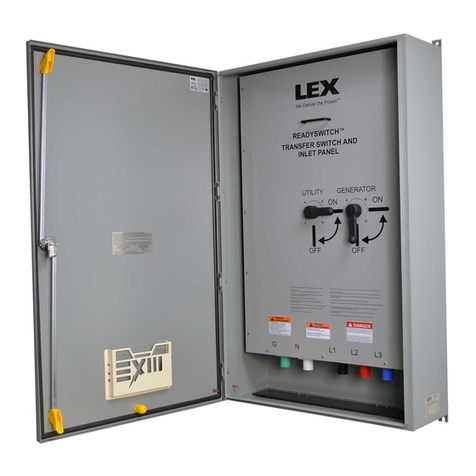
PowerGATE™ Emergency Lighting Transfer Switch
–Remove the shorting jumper from between the “AUX” terminal blocks and connect your auxiliary control conductors
– NOTE: If the Auxiliary activation circuit is not going to be used, leave the shorting jumper in place
Connecting the Generator / Engine start circuit:
–The ELTS can be used to start a standby generator in the event of a power failure or emergency event
• Please note that your generator must support the remote start feature
• Consult your generator manual for details
–When the ELTS is in Emergency mode the GEN contacts are closed providing a closed circuit to the generator.
–To connect the Generator Start signal wires, rst locate the terminal block marked GEN, AUX, FA on the right side of the panel
• Connect your generator control conductors to the terminals marked GEN
– NOTE: Refer to your generator installation manual for start circuit wiring details
Step 4: Connecting Power (continued)
208V Monitoring Connections:
–The ELTS monitors the normal power to determine when a normal power failure occurs
–Sensing wires are required from a 3-pole breaker (not included) plus neutral, from the same normal feed as the circuits being
transferred
–Connect the sensing wires from the normal feed to the three phases and neutral on the terminal block labelled 208 VAC Monitored Power
–Terminals accept #22-#10 AWG conductors and should be tightened to 25 lb-in
– NOTE: Power sensing conductors must be 12 AWG or larger
Connecting the Fire Alarm Interface:
–You can connect your system to a re alarm interface so that it switches to the emergency mode when the re alarm is triggered
–The interfacing re alarm system is a 120 VAC circuit that must be able to provide an
open signal when it activates
–To connect the Fire Alarm signal wires, locate the terminal block marked Gen, Aux,
FA on the right side of the panel
–Remove the shorting jumper from between the “FA” terminals and connect your re
alarm control conductors.
– NOTE: If the Fire Alarm activation circuit is not going to be used, leave the shorting
jumper in place.
Connecting the Auxiliary Interface:
–You may connect your system to an auxiliary interface so that it switches to the
emergency mode when the auxiliary circuit is opened
–An example of an Auxiliary device would be a remote key switch
–Your auxiliary circuit is a 120 VAC circuit that must be able to provide an open signal
when it activates
–To connect the Auxiliary device signal wires, rst locate the terminal block marked GEN,
AUX, FA on the right side of the panel




























